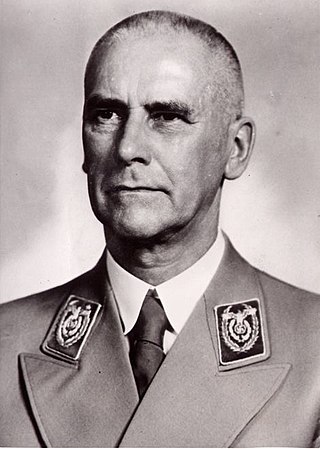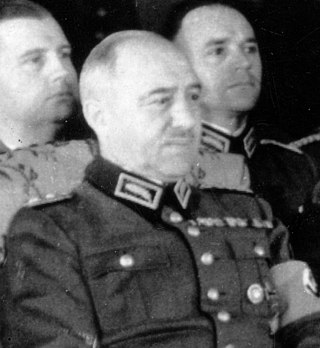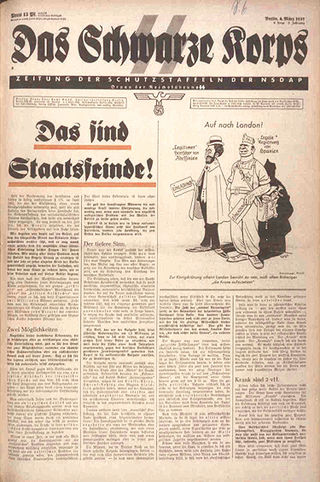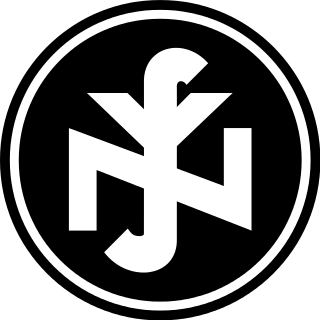The Nazi term Gleichschaltung or "coordination" was the process of Nazification by which Adolf Hitler — leader of the Nazi Party in Germany — successively established a system of totalitarian control and coordination over all aspects of German society "from the economy and trade associations to the media, culture and education". Although the Weimar Constitution remained nominally in effect until Germany's surrender following World War II, near total Nazification had been secured by the 1935 resolutions approved during the Nuremberg Rally, when the symbols of the Nazi Party and the state were fused and German Jews were deprived of their citizenship. The tenets of Gleichschaltung also applied to territories occupied by the Nazis.

The Nazi Party, officially the National Socialist German Workers' Party, was a far-right political party in Germany active between 1920 and 1945 that created and supported the ideology of Nazism. Its precursor, the German Workers' Party, existed from 1919 to 1920. The Nazi Party emerged from the extremist German nationalist, racist and populist Freikorps paramilitary culture, which fought against communist uprisings in post–World War I Germany. The party was created to draw workers away from communism and into völkisch nationalism. Initially, Nazi political strategy focused on anti–big business, anti-bourgeois, and anti-capitalist rhetoric; it was later downplayed to gain the support of business leaders. By the 1930s, the party's main focus shifted to antisemitic and anti-Marxist themes. The party had little popular support until the Great Depression, when worsening living standards and widespread unemployment drove Germans into political extremism.

Wilhelm Frick was a convicted war criminal and prominent German politician of the Nazi Party (NSDAP) who served as Minister of the Interior in Adolf Hitler's cabinet from 1933 to 1943 and as the last governor of the Protectorate of Bohemia and Moravia.

Fritz Todt was a German construction engineer and senior figure of the Nazi Party. He was the founder of Organisation Todt (OT), a military-engineering organisation that supplied German industry with forced labour, and served as Reich Minister for Armaments and Ammunition in Nazi Germany early in World War II, directing the entire German wartime military economy from that position.

Dr. Walter Gross was a German physician appointed to create the Office for Enlightenment on Population Policy and Racial Welfare for the Nazi Party. He headed this office, renamed the Office of Racial Policy in 1934, until his suicide at the close of World War II.
This is a list of words, terms, concepts and slogans of Nazi Germany used in the historiography covering the Nazi regime. Some words were coined by Adolf Hitler and other Nazi Party members. Other words and concepts were borrowed and appropriated, and other terms were already in use during the Weimar Republic. Finally, some are taken from Germany's cultural tradition.

Erich Koch was a Gauleiter of the Nazi Party (NSDAP) in East Prussia from 1 October 1928 until 1945. Between 1941 and 1945 he was Chief of Civil Administration of Bezirk Bialystok. During this period, he was also the Reichskommissar in Reichskommissariat Ukraine from September 1941 until August 1944 and in Reichskommissariat Ostland from September 1944. After the Second World War, Koch stood trial in Poland and was convicted in 1959 of war crimes and sentenced to death. The sentence was later commuted to life in prison and Koch died of natural causes in his cell at the Barczewo prison on 12 November 1986.

Gertrud Emma Scholtz-Klink, bornTreusch, later known as Maria Stuckebrock, was a Nazi Party member and leader of the National Socialist Women's League (NS-Frauenschaft) in Nazi Germany.
Volksgemeinschaft is a German expression meaning "people's community", "folk community", "national community", or "racial community", depending on the translation of its component term Volk. This expression originally became popular during World War I as Germans rallied in support of the war, and many experienced "relief that at one fell swoop all social and political divisions could be solved in the great national equation". The idea of a Volksgemeinschaft was rooted in the notion of uniting people across class divides to achieve a national purpose, and the hope that national unity would "obliterate all conflicts - between employers and employees, town and countryside, producers and consumers, industry and craft".

Konstantin Hierl was a major figure in the administration of Nazi Germany. He was the head of the Reich Labour Service a Reichsleiter of the Nazi Party and an associate of Adolf Hitler before he came to national power.

Das Schwarze Korps was the official newspaper of the Schutzstaffel (SS). This newspaper was published on Wednesdays and distributed free of charge. All SS members were encouraged to read it. The chief editor was SS leader Gunter d'Alquen; the publisher was Max Amann of the Franz-Eher-Verlag publishing company. The paper was hostile to many groups, with frequent articles condemning the Catholic Church, Jews, Communism, Freemasonry, and others.

The Nazi Party/Foreign Organization was a branch of the Nazi Party and the 43rd and only non-territorial Gau ("region") of the Party. In German, the organization is referred to as NSDAP/AO, "AO" being the abbreviation of the German compound word Auslands-Organisation. Although Auslands-Organisation would be correctly written as one word, the Nazis chose an obsolete spelling with a hyphen.

Adolf Hühnlein was a German soldier and Nazi Party (NSDAP) official. He was the Korpsführer of the National Socialist Motor Corps (NSKK) from 1933 until his death in 1942.

The Office of Racial Policy was a department of the Nazi Party (NSDAP) that was founded for "unifying and supervising all indoctrination and propaganda work in the field of population and racial politics". It began in 1933 as the Nazi Party Office for Enlightenment on Population Policy and Racial Welfare. By 1935, it had been renamed to the Nazi Party Office of Racial Policy.

The Winterhilfswerk des Deutschen Volkes, commonly known by its abbreviated form Winterhilfswerk (WHW), was an annual donation drive by the National Socialist People's Welfare to help finance charitable work. Initially an emergency measure to support people during the Great Depression, it went on to become a major source of funding for the activities of the NSV and a major component of Germany's welfare state. Donations to the WHW, which were voluntary in name but de facto required of German citizens, supplanted tax-funded welfare institutions and freed up money for rearmament. Furthermore, it had the propagandistic role of publicly staging the solidarity of the Volksgemeinschaft.

The government of Nazi Germany was a totalitarian dictatorship governed by Adolf Hitler and the Nazi Party according to the Führerprinzip. Nazi Germany was established in January 1933 with the appointment of Adolf Hitler as Chancellor of Germany, followed by suspension of basic rights with the Reichstag Fire Decree and the Enabling Act which gave Hitler's regime the power to pass and enforce laws without the involvement of the Reichstag or German president, and de facto ended with Germany's surrender in World War II on 8 May 1945 and de jure ended with the Berlin Declaration on 5 June 1945.

The National Socialist People's Welfare was a social welfare organization during the Third Reich. The NSV was originally established in 1931 as a small Nazi Party-affiliated charity, which was active locally in the city of Berlin. On 3 May 1933, shortly after the Nazi Party took power in Weimar Germany, Adolf Hitler turned it into a party organization that was to be active throughout the country. The structure of the NSV was based on the Nazi Party model, with local (Ort), county (Kreis) and district (Gau) administrations.
Hans Albert Hohnfeldt was a member of the Nazi Party (NSDAP) who served as Gauleiter in the Free City of Danzig and acting Gauleiter of Gau East Prussia. He also held other Party and government posts in the Free City of Danzig.
Karl Lenz was a Nazi Party (NSDAP) official who served as the third and last Gauleiter of Gau Hesse-Darmstadt. He was also an officer in the Allgemeine SS and the Waffen-SS.












